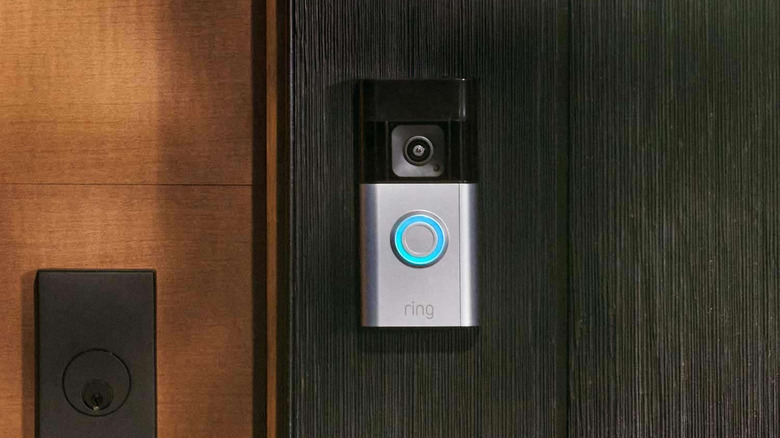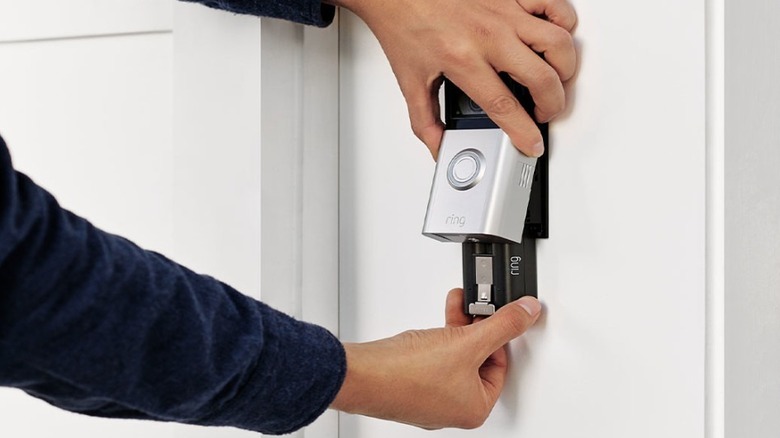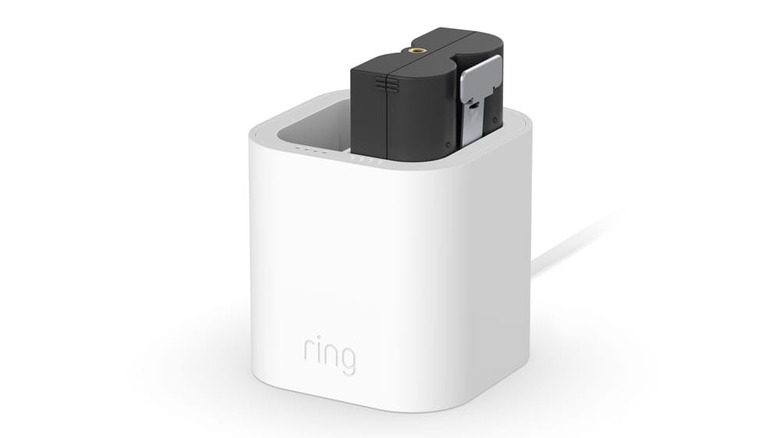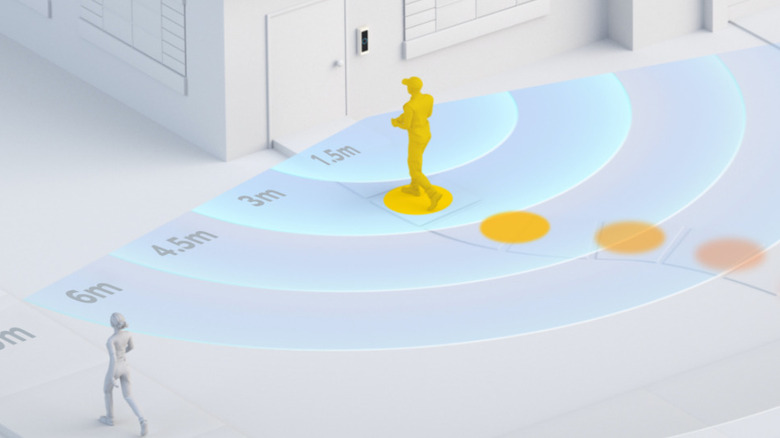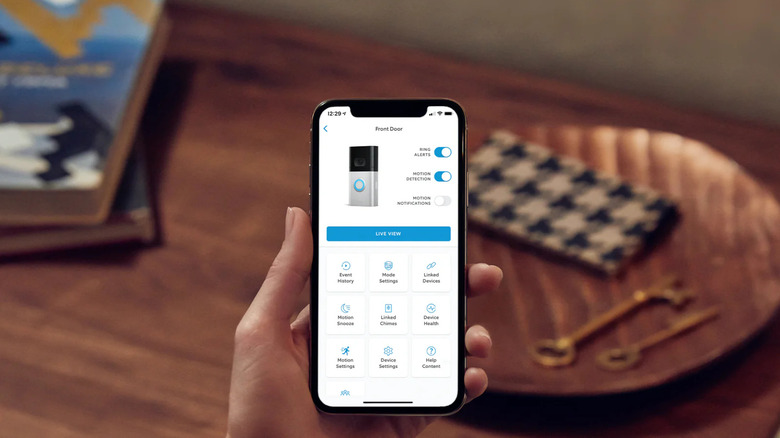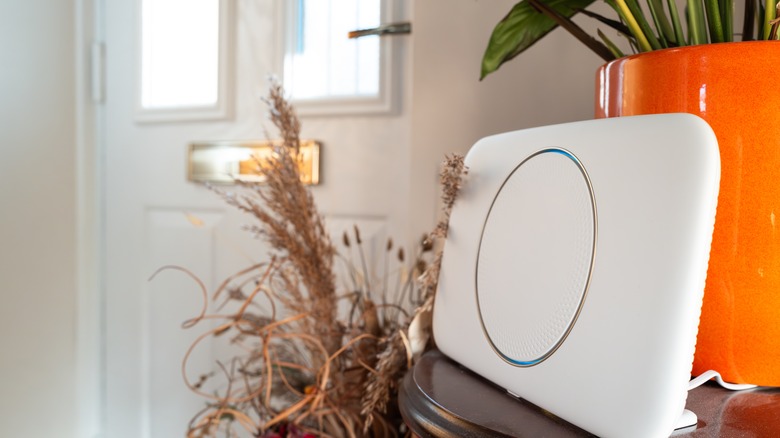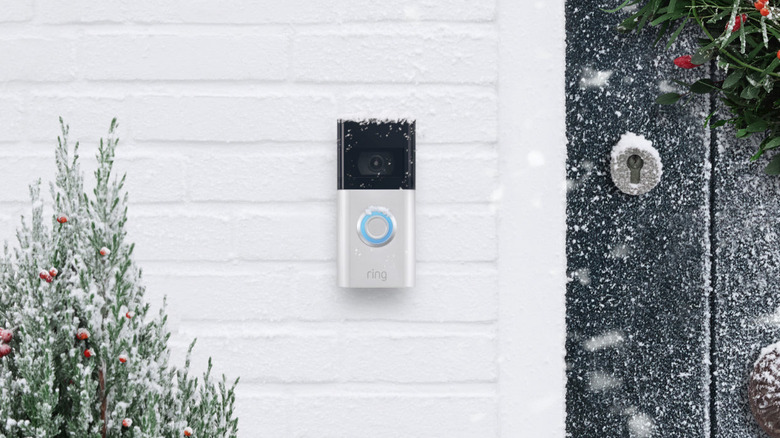How Long Does The Battery Last On A Ring Doorbell?
When it comes to reliability and simplicity of use, the traditional doorbell is unmatched. You install it, push the button, and hear a chime — that's all there really is to it. But then again, with everything being connected these days, you'll probably prefer installing a smart doorbell like Ring instead. Smart doorbells may require additional setup and accessories, but they're worth it for the most part, especially with the convenience they provide. A few taps on the doorbell's companion mobile app and you can immediately see what's happening on your front door. Plus, you get notifications when someone is on your property even if they don't ring your doorbell.
The best part about smart doorbells, specifically Ring ones, is that there is a battery-powered version. That means you don't need to deal with any wiring, and you can move it wherever and whenever. However, with battery-operated Ring doorbells, there's always the question of how well the batteries will last before you need to recharge them. Let's take a look at the Ring doorbell's battery life and ways to extend it to better meet your needs.
What to expect from your Ring doorbell's battery
According to Ring, its batteries can last for several months under standard usage of about 1,000 activations. These activations include events that trigger the camera, such as motion detection or when the live view is accessed. So if you have 15 activations a day, your Ring doorbell's battery can last you roughly 60 days. This is the typical case for users in a real-life setting (they report going two to three months between battery charges). However, others experience a much shorter battery life with their devices, with a few reporting as little as one to two weeks.
Between Ring doorbell models, there's no definitive answer for how long each model's battery will last. Most of the battery-operated Ring models are actually powered by the same battery — the Quick Release Battery Pack, which delivers either 5800mAh or 5960mAh. But despite this, the actual runtime of the doorbell models might vary from each other. For instance, the Battery Doorbell Pro that comes complete with 3D motion detection, bird's eye view, and person detection, can only get you through two weeks on a full charge based on our review. On the other hand, the Battery Doorbell Plus that lacks some of the features of the Pro runs for six months as some users reported on Reddit. And yet the Video Doorbell 2nd Gen, which includes even less advanced features than the Plus and Pro, can last somewhere around five to ten weeks.
Why your Ring doorbell's battery is draining so fast
The amount of time before you need to charge your Ring doorbell's battery depends on a host of factors. At the top of the list of culprits for your battery draining faster than you expect is the doorbell's activity levels. As you know, you have a 1,000-activation limit on your battery. This means the busier your doorbell gets, the more often you'd need to recharge it. Enabling all the features of your Ring doorbell is also a surefire way to run down its battery levels. Sure, you likely want to get the most out of the device, but you also have to keep in mind that making it work at its maximum capacity has trade-offs, one of the most noticeable being the rapid battery consumption.
Another reason behind your battery depleting quickly may be weak Wi-Fi signal. When the connection between your Ring doorbell and router is poor, your doorbell has to put in more effort to stay connected. Once the connection does drop, your device will continuously attempt to reconnect to your Wi-Fi, consuming battery life in the process. For Ring doorbell models using the removable Quick Release Battery Pack, swapping the batteries out for third-party ones could potentially deplete your battery faster as well. After all, off-brand batteries are guaranteed to work with your Ring doorbell. And finally, there's the issue about weather. The Ring doorbell's battery, while weather-resistant, can only operate at temperatures of -5°F to 120°F (-20.5°C to 48.5°C). However, its performance drops once the temperatures go below 40°F, at which point more frequently recharges are needed.
Now that you know why your Ring doorbell's battery life is shorter than you'd hoped, you can take the necessary steps to extend it. Here are some tips to address each of these battery drain culprits.
Tip #1: Reduce activity levels
To lessen the activations your doorbell registers every day, you might want to limit the area the device monitors. For instance, if you're capturing even your neighbor's activities across the street, then it may be time to relocate your Ring doorbell range to a spot where it would only detect people coming to your door. There are also three configurations you can change in the app: the Motion Zones, Motion Sensitivity, and Motion Frequency. Follow these steps to edit them:
- Launch the Ring app.
- On the home page, tap the gear icon on your camera's live feed to open the device settings.
- Press Motion Settings.
- Reselect the Motion Zones, a.k.a. the only areas your doorbell will monitor for motion:
- In the Motion Settings page, tap on Camera Motion Zones.
- Choose a zone to edit.
- Drag the points to cover the areas you want to cover.
- Hit Save.
- If you want to delete the selected zone instead, tap on the trash icon.
- Change the sensitivity of the motion detection:
- Go to Motion Sensitivity in the Motion Settings page.
- Drag the slider towards the minimum end.
- Tap Save.
- Adjust how often your doorbell scans for motion:
- While in the Motion Settings page, navigate to Advanced Settings > Motion Frequency.
- Switch to Regularly for moderate battery life or Periodically for longest battery life.
- Press Save.
Another important step to take to reduce your Ring doorbell's activity levels is avoiding frequent access to the Live View.
Tip #2: Deactivate some unused features
While the Ring doorbell comes with amazing features, that doesn't necessarily mean you have to enable all of them. You might not have a need for some of these functionalities, so it's best to simply deactivate them to improve your doorbell's battery life. Here are some suggested features to tweak in the Ring app:
- Go to the settings page of your Ring doorbell.
- Turn off Snapshot Capture, which regularly takes photos:
- Select the Device Settings tile.
- Tap on Snapshot Capture.
- Switch off the toggle for Snapshot Capture.
- Alternatively, set a different snapshot frequency to minimize how often the doorbell takes images.
- Hit Save.
- Shorten the Video Recording Length (how long the doorbell records a video after it detected motion):
- Go to the Device Settings tile.
- Select Video Settings.
- Tap on Recording Length.
- Choose a short duration. Some users experienced a better battery life with only a 20-second video length.
- Press Save at the top.
- Switch off Advanced Motion Detection, which does a couple of things, such as enable Customizable Motion Zones, automatically trim video recordings, and increase detection accuracy:
- Tap on the Motion Settings tile.
- Navigate to Advanced Settings > Advanced Motion Detection.
- Click on Advanced Motion Detection to disable it.
- Press Disable Feature on the popup to confirm.
- Turn off Bird's Eye Zones, which provides an aerial map with the path your guests took while on your property:
- Choose the 3D Motion Settings tile.
- Press Bird's Eye Zones.
- Disable the option for Use Bird's Eye Zones.
You don't have to follow these recommendations to a tee, though. You can take some time to fiddle around with these configurations to get the optimum settings for your needs.
Tip #3: Fix your Wi-Fi connection
It's easy to assume that your Ring doorbell's router connection is strong enough because everything seems to be working as expected. However, under the hood, the device might actually be poorly connected to your network, causing your battery to deplete quickly. To verify which case is true for you, check the Received Signal Strength Indicator (RSSI) of your doorbell. This tells you how good your doorbell's Wi-Fi connection is. You can find the RSSI by going to the doorbell's settings page in the Ring app and navigating to Device Health. In the Signal Strength section, you'll see your RSSI. Anywhere above RSSI-71 is poor, RSSI-61 to -70 needs improvement, RSSI-51 to -60 is adequate, and RSSI-50 and below is ideal. If your RSSI falls in the poor or "needs improvement" category, consider these fixes to boost your home Wi-Fi network:
- Move your router closer to the doorbell.
- Make sure your router is mounted on an open space, not tucked away behind large obstacles like closets and couches.
- Remove items like fish tanks, big mirrors, electronics, and large metal appliances away from the router to prevent distortion.
- Get a Chime Pro or a third-party Wi-Fi extender if you can't physically move your router or if there's one or more walls between your router and doorbell.
- Try using a different router.
It's also important to ensure that your Wi-Fi is providing at least 2 Mbps speeds. To check how fast your internet is, stand near your doorbell and visit a speed test site on your smartphone.
Tip #4: Take care of your battery during winter
If you've had your Ring doorbell for a while now, you might have already noticed that the battery drains much quicker in the winter and returns to its normal performance in the summer. Unfortunately, you can't change the weather, but what you can do is keep your battery from degrading during the cold season.
One of the primary things you need to do once winter rolls around is to frequently monitor your battery to see if it needs a recharge. To do so, open the Ring app and go to the doorbell's settings. Then, choose the Device Health tile. Under the Power section, you should see what battery percentage your doorbell is currently at. You may need to do this multiple times a week, especially once temperatures reach 36°F (3°C). This is when the battery starts struggling to stay charged. At 32°F (0°C), your battery might stop charging, even from hardwire connections. In this case, remove the battery, take it with you indoors, wait for it to reach room temperature, and then charge it to 100%. When temperatures get to -5°F (-20.5°C), however, it's possible for your battery to stop functioning altogether. You can only wait for the warm weather to come before you use your Ring doorbell again. In the meantime, look for alternative methods to keep an eye on your front door. You might even want to switch to a wired Ring doorbell instead.
Tip #5: Connect your Ring doorbell to hardwired, solar, or plug-in charger
Once you see your Ring doorbell's battery running low, what you'd normally do is take it out to charge it. However, this poses two drawbacks. First, charging typically takes hours. With a USB cable, you have to wait between six and eight hours, but it can also go up to ten hours if the battery charge is already below 20%. You can use the Ring Charging Station to speed things up as it can fully charge your battery within 4.5 hours. However, you'd still have to go at least four hours with no front door protection, which leads to the second drawback: buying spare battery packs to keep your device on at all times. The official Ring battery packs are nowhere near cheap, and if you go with the more affordable off-brand batteries, you can't guarantee they will work or even last.
To solve this dilemma, you can charge your Ring doorbell with hardwired power, solar charger, or plug-in adapter instead. Connecting your Ring doorbell to hardwired power means using either a doorbell power supply already installed in your home or a compatible doorbell transformer with specifications of 8 to 24 VAC, 50/60Hz, and 5VA to 40VA. For the transformer option, you might need to consult with a professional first. Also, take note that the hardwire power only charges your doorbell, meaning your device still runs on its battery. If you prefer to install a solar charger, make sure your location gets three to four hours of intense sunlight and the panel isn't blocked by any shade. If, however, you don't want the hassle of hardwiring your doorbell or installing a solar charger, you can use the official plug-in adapter instead. It works just like a typical charger that you plug into an outlet and connect to your doorbell.
